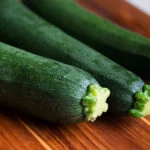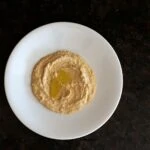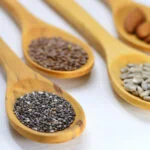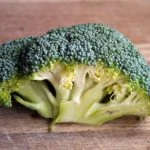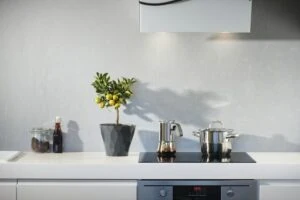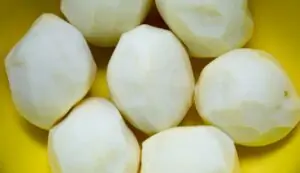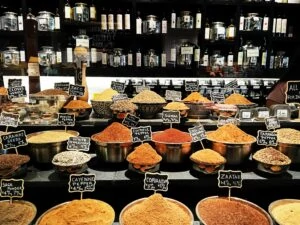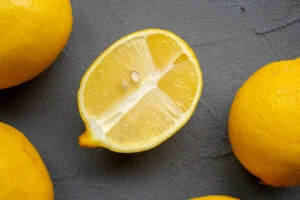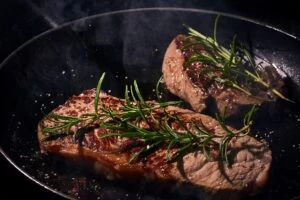Nut butter is a healthy option for any diet. It is a great source of sugars, protein, and fats that allow individuals to feel more satisfied after consuming a meal. Homemade versions of almond butter, peanut butter, cashew butter tend to be tastier than store-bought as people can incorporate their own nut combinations and textures. While making your own delicious nut butter may be challenging at first, our best blender for nut butter makes the job easy.
Nut butters enter into different phases while being blended, and there will be some stark textural changes within seconds of blending. When making your own nut butter, use a spatula or tamper to allow the nuts to blend more evenly.
If the blender becomes hot, loud, or requires a longer time to process, switch to one-minute intervals to decrease the stress on the blender and prevent it from breaking down. Also, to speed things up, roast the nuts before placing them in the blender. Allow your roasted almonds or roasted peanuts to cool to room temperature before blending them.
What Features Do You Need to Make the Best Nut Butter?
Most experts in this area recommend a high-quality blender as this kitchen appliance gives you several advantages. They contain a more powerful motor than cheaper blenders and give you smoother textures with less effort. They can grind through nuts, which are challenging to begin with, and not stress or overheat.
These blenders are quieter than cheaper models and rattle less. They are less likely to break down from the stress of continually grinding nuts. Nuts are difficult to grind to a smooth paste and place undue pressure on a blender.
You can use higher-quality blenders for a long time because they are more durable and have better parts designed for this task alone. Not all blenders can do this function.
Selecting the best blender may be challenging due to the options available. Consider power, jar size, speed, design, and speed when deciding.
Power to Cut Through Hard Nuts
Nuts are extremely hard to blend. While they break down into smooth butter or milk with the correct prep, their hardness can quickly wear down the blades. A good nut butter blender has a lot of power to convert them into a smooth texture. You can use a motor with less wattage, but they will easily burn out.
For nut butter, you need a blender with 1,000 watts or more. Power doesn’t translate to speed; however, it does mean that there will be more consistency with the blade accompanied by enough power to go through heavy patches of nuts as they begin to break down into a smooth texture.
Speed For That Perfect Blend
Look for a blender with four-plus settings- ten being the ideal. Variations in speed are best when making nut butter. Fast speeds will break down the nuts quicker into something more manageable for the blades. Milling speeds will turn coarse butter into creamier spreads.
Speeds will also help you process various nuts for variations in taste. Please note that higher speeds may cause the blender to heat up if left on for too long. This heat is hard on your blender, and it may wear down quicker. For longer periods of use, blending in intervals is best, and it is less stressful on the device.
Also, the flavor of the nut butter changes if it is warmed, which is more noticeable if you are using a more delicate nut, like cashews.
As a bonus, having a blender with multiple speed settings means you can use it for other things, too, like green smoothies, hot soup, or add some ice cream and frozen fruit for a sweet dessert.
Durable Material
When choosing your material, select glass jars over plastic. Glass jars will be more durable and are easily washed, but a good-quality plastic jar may be a viable option since they are lightweight and can be less thermal sensitive.
When considering glass, choose one made of Pyrex. Pyrex is more durable, will not retain the scent of the food you are making, is stain resistant, and can handle hot/cold foods. Since all glass is not created equally, always consult with your manual before introducing any foods into them as they may crack or break.
If using a plastic jar, look for something scratch-resistant and durable, which will make purchasing a blender for nut butter more affordable. Make sure the jar is BPA-free and can handle hot/cold elements.
Avoid plastics made from BPA at all costs. BPA contains harmful chemicals that leach into food. While they strengthen the plastic, BPA is harmful when consumed and will alter the taste of whatever you place in the container.
Most kitchen products are thankfully BPA-free; however, always be sure before purchasing.
Proper Jar Size
Many people make nut butter in large batches as they have a long shelf-life, so you can make it less frequently. Most experts recommend purchasing a blender with jars beginning at 32 oz. It is also not recommended to fill the jars to the top when first starting.
Larger jars will allow you to make bigger batches. However, the nuts should be added to the blender slowly with only a small portion at each time to eliminate the blender overheating and burning out.
Designs That Create the Best Texture
Find a blender with a round jar that’s wide at the top and narrow at the bottom. This shape works better for blending nut butters than containers with a universal width or those that are squared.
A blender with a wider base generates more stability and reduces rocking. The base of the jar should be narrower and should rest upon a wider base.
Top Picks for Blenders for Making Nut Butter
1. Best High Quality: Vitamix 7500 Blender
Vitamix is known to produce high-quality, durable blenders. Even though it does not contain a noise shield like some other brands, this blender is still quiet. Additionally, each component uses the best materials, making it long-lasting.
The best feature of this blender is that it encourages food turnover. It ensures nut butters are fully creamy as opposed to gritty. The 64 oz container holds large batches of nut butter, and it handles most ingredients with ease.
This self-cleaning blender takes up very little room, and you can easily store it underneath counters.
Pros:
- 120-volt motor
- Adjustable speeds and pulse
- Comes with tamper to process thick blends of food/scrape sides
- Vortex action creates a smoother blend
Cons:
- Doesn’t blend smaller batches well
- Need to hold down the blender while in operation
2. Best Budget: Instant Pot Ace Nova Blender
This affordable blender offers some unique features. It blends food and, much like the Vitamix, heats it as well. Food will remain heated in the blender for up to two hours after blending.
Its Smart Program cleans residue and food from the blades and pitcher within one minute. You can remove the rest of the residue with the included cleaning brush.
Pros:
- 1000-Watt motor
- 110 Volts
- Ten-speed settings
- Is versatile and great for smaller spaces (low profile)
Cons:
- Small portions may overheat
- Plastic item close to motor melts if the blender becomes too hot
- Louder model of blender
3. Most Quiet: Hamilton Beach SoundSheild
The SoundSheild offers the quiet operation and power of commercial blenders to the kitchen. You can make smoothies, crush ice, and blend almost any food with one touch. Durable stainless-steel blades fit easily into the base with a simple twist, and this blender comes with a 52 oz glass jar.
The glass jar is brilliantly designed to push food toward the base, while the dome-shaped lid provides food space to go down to the blades. A sensor located in the motor will maintain the speed. Additionally, the muffled chambers and two-piece shield reduce sound while blending.
Pros:
- 950 Watts of power
- 5 speed controls
- Drip-free spout
- Dishwasher safe
Cons:
- SoundShield muffles noise but is still a little on the loud side
- Good for nut butter, but may leave chunks when used for some fruits
4. Best All-Purpose Blender: NutriBullet ZNBF30400Z Blender
Another well-known powerful blender that handles nuts well is NutriBullet. Nutri-bullet expanded its product line by including a more mid-range blender, and you can use it for a variety of foods.
It has a narrower bottom compared to other blenders but widens out quicker. Therefore, it does an adequate job mixing foods in the blender. It comes with a 64 oz jar, tamper, and vented lids which maintain an even pressure while in use.
Pros:
- 1200-Watt motor
- Can be placed in dishwasher
- Three speeds
- Comprised of stainless steel
- One year warranty
Cons:
- Can only be run in one-minute intervals
- Refrain from going past the max line as it can lead to leakage
5. Best for Smooth Nut Butters: Ninja Foodi Smoothie Bowl Maker
This BPA-free blender easily breaks down nuts into a smooth, creamy, buttery texture. The Smooth Nutrient Extractions allow for an improved breakdown generating an even smoother texture.
Furthermore, Smart Torque Technology provides a power-dense motor that goes through heavier ingredients without overheating, stalling, or requiring the user to shake the ingredients. The shape enables users to blend their food hands-free, and it is quick to operate.
Pros:
- 1200-Watt motor
- Six speeds
- Hybrid blades made of high-grade stainless steel
- Can blend, pulse, and pause
- Built-in tamper
Cons:
- Smaller than other blenders (14-24 oz)
- Louder than other models
6. Designed Specifically for Nut Butters: NutraMilk Nut Processor
While this machine is designed to make nut butter and nut milk, some users may find it limiting and less versatile. That said, it is ideal for people who love or eat a great deal of nut butter and can handle the hard texture of nuts with ease.
It is easy to clean and maintain as it is dishwasher safe, and it eliminates wasted food as you can use all parts of the nut. You won’t have to strain your butter to get out pieces of nuts.
Pros:
- 500-Watt motor
- BPA free
- Blends up to five cups of nuts/seed
- Blades reach food throughout container
Cons:
- Small capacity
- Not versatile
7. Tied: Brewista BRNMSMS Nut Butter and Smoothie Blender
This machine is made from BPA-free polypropylene, and the stainless-steel blades can create butters and smoothies within minutes. Clean-up is exceptionally easy, and it is dishwasher safe.
Pros:
- 220 volts
- Easy to clean
Cons:
- May need to strain materials otherwise it may be gritty
- Some plastic parts
Keeping Blender Clean from Nut Butter
Leftover particles of food can easily contaminate your blender. Yet most people are unaware of how to care for and clean their blenders. Some are not particularly easy to clean and may take some time. However, safety and sanitation should always be the goal of any appliance.
If the blender is improperly cleaned, you will notice the food you make with it tastes off. The worst-case scenario is food poisoning.
Furthermore, cleaning the base is equally important to clean as the container. Food bits easily collect on the base, and while they may never enter the food being blended, they will still spread bacteria and germs on the countertop. Cleaning all components just keeps things safe for everyone.
When cleaning a blender, some common errors include:
- Only completing the self-clean setting on the blender
- Not cleaning the base of the blender every time
- Not properly rinsing the blender
- Avoiding washing the accessories and lid
While most people love the self-cleaning feature on a blender, they make the mistake of believing that once they use it, the blender is clean, but this is not the case. Using it in self-clean mode requires three minutes of running the blender with hot water and soap. There are even some models that heat the water for added cleaning action.
While this option saves time and will clean the blades, it doesn’t do a thorough clean or get underneath the blades where most food resides. It doesn’t run long enough to sanitize the blender and leaves the bottom cleaner than the top because of how long it takes for water and soap to foam adequately to fill an entire jar.
While adding water may reach the lid, it tends to overflow.
Self-clean is more of maintenance as opposed to a deep clean. The blender will still need a thorough cleaning before its next use. Instead, use a sponge to remove any stuck-on food or food particles. Wipe down the blades, inside of the jar, and lid as well.
Some tips to keep your blender in top condition are:
- Rinse the blender with water and regular dish soap to remove biofilms resulting from probiotic foods. If left unchecked, these foods form bacteria causing mold to form.
- Monthly, fill the blender up to the fill line with water. Add soap and mix. Allow it to sit for five to ten minutes to sanitize it. Dump the water and run the blender in self-cleaning mode.
- If the blender becomes smelly, use vinegar, baking soda, and lemon to make it fresh smelling. Mix a bit of baking soda in water to make a slurry. Then, fill the bender and allow it to soak for one hour. Drain the blender and clean as per usual.
- Vinegar will additionally remove odors from a blender. To use it, wash the inside with a sponge soaked in vinegar. Remove the blender blades before soaking, and rinse with warm water.
- Lemon juice will remove stubborn stains from the blender. Squeeze it onto the affected area and allow it to sit for one hour. Scrub the area and then rinse the blender.
These tips will allow you to keep your blender in top-performing condition. You will need to regularly get into all the nooks and crannies of your blender, thoroughly clean the blades, and handwash your accessories. This will prolong the use of the blender and keep your family safe from harmful bacteria.
When creating a nut butter with a blender, you need something with at least 1,000 watts of power for large batches. While you can use a lesser wattage, we don’t recommend it. Blending nuts due to their hard texture can be hard on the blades of a blender. If the blender doesn’t have enough power, it will quickly overheat.
Furthermore, if the blender has inadequate power, it will not do as good of a job blending the nuts. The result will be a gritty product, strange tasting, and something you may need to strain.
Blenders with a vortex action will blend the contents better over most of their competition. The vortex draws finer particles upward while leaving larger chunks at the blade level for chopping. It creates a smoother texture and can capture larger chunks.
Also, they tend to get all portions of the container. This results in more of the nut being used to make the butter and no food left behind, eliminating waste and giving you a better product.
In determining the best blender for nut butter, we did place a heavier emphasis on speed settings, power, and materials. These are the main components to look for when purchasing a blender. The blender needs to be powerful enough to blend through the nuts, and the blades need to be durable enough to withstand the force needed to blend them into a smooth texture.
Stainless steel blades tend to be superior to any other material, are durable, and stay sharper for a longer duration. They simply don’t break down as easily. Speed settings are additionally valuable as you should do a pulsing action for larger batches to preserve the motor.
This material will also allow you to further customize the texture to your preferences and experiment using various nuts as well.
All these areas combined will create the perfect blender for your nut butter. Whether you want something smooth or a little chunkier, there is an ideal blender for you. It just depends on how much you want to make, how much you consume, and the texture you need. Also, some blades are better over others, depending on the nut. Choose one that will do the best job for you!
FAQ
Can you successfully make nut butter using a blender?
Yes, you can! Depending on the power, many blenders make smooth nut butter within minutes. If you like soft, creamy nut butter creamy, select a blender with a good motor, a variety of settings, and good cyclonic action. The nuts blend more smoothly because the larger components are drawn to the bottom.
What is the shelf-life of nut butter?
Homemade nut butter may expire quicker than store-bought varieties. This is especially noticeable if you don’t add natural preservatives or salt to the mixture. Most homemade almond butter and other recipes will last for one month if refrigerated or three to six months if frozen. If you don’t want to add preservatives or salt, refrain from storing it on a shelf as it may quickly turn.

